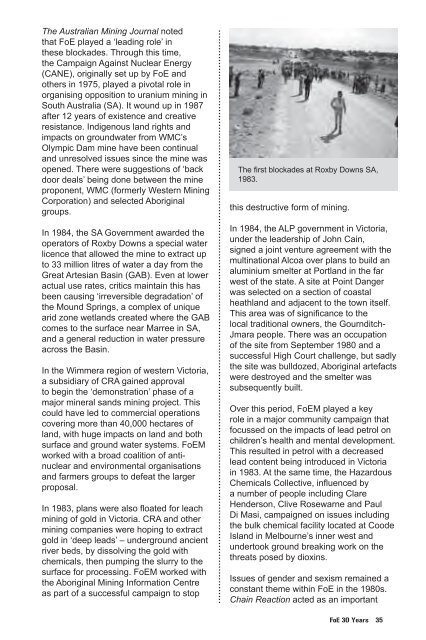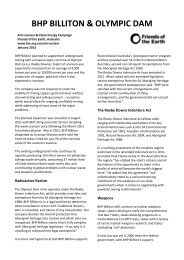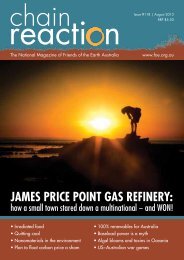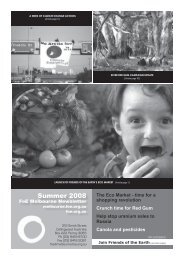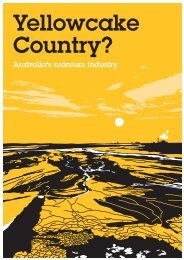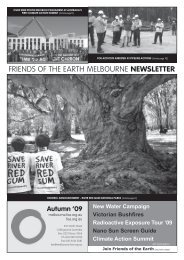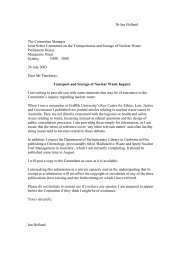Thirty Years of Creative Resistance - Friends of the Earth Australia
Thirty Years of Creative Resistance - Friends of the Earth Australia
Thirty Years of Creative Resistance - Friends of the Earth Australia
Create successful ePaper yourself
Turn your PDF publications into a flip-book with our unique Google optimized e-Paper software.
The <strong>Australia</strong>n Mining Journal noted<br />
that FoE played a ‘leading role’ in<br />
<strong>the</strong>se blockades. Through this time,<br />
<strong>the</strong> Campaign Against Nuclear Energy<br />
(CANE), originally set up by FoE and<br />
o<strong>the</strong>rs in 1975, played a pivotal role in<br />
organising opposition to uranium mining in<br />
South <strong>Australia</strong> (SA). It wound up in 1987<br />
after 12 years <strong>of</strong> existence and creative<br />
resistance. Indigenous land rights and<br />
impacts on groundwater from WMC’s<br />
Olympic Dam mine have been continual<br />
and unresolved issues since <strong>the</strong> mine was<br />
opened. There were suggestions <strong>of</strong> ‘back<br />
door deals’ being done between <strong>the</strong> mine<br />
proponent, WMC (formerly Western Mining<br />
Corporation) and selected Aboriginal<br />
groups.<br />
In 1984, <strong>the</strong> SA Government awarded <strong>the</strong><br />
operators <strong>of</strong> Roxby Downs a special water<br />
licence that allowed <strong>the</strong> mine to extract up<br />
to 33 million litres <strong>of</strong> water a day from <strong>the</strong><br />
Great Artesian Basin (GAB). Even at lower<br />
actual use rates, critics maintain this has<br />
been causing ‘irreversible degradation’ <strong>of</strong><br />
<strong>the</strong> Mound Springs, a complex <strong>of</strong> unique<br />
arid zone wetlands created where <strong>the</strong> GAB<br />
comes to <strong>the</strong> surface near Marree in SA,<br />
and a general reduction in water pressure<br />
across <strong>the</strong> Basin.<br />
In <strong>the</strong> Wimmera region <strong>of</strong> western Victoria,<br />
a subsidiary <strong>of</strong> CRA gained approval<br />
to begin <strong>the</strong> ‘demonstration’ phase <strong>of</strong> a<br />
major mineral sands mining project. This<br />
could have led to commercial operations<br />
covering more than 40,000 hectares <strong>of</strong><br />
land, with huge impacts on land and both<br />
surface and ground water systems. FoEM<br />
worked with a broad coalition <strong>of</strong> antinuclear<br />
and environmental organisations<br />
and farmers groups to defeat <strong>the</strong> larger<br />
proposal.<br />
In 1983, plans were also floated for leach<br />
mining <strong>of</strong> gold in Victoria. CRA and o<strong>the</strong>r<br />
mining companies were hoping to extract<br />
gold in ‘deep leads’ – underground ancient<br />
river beds, by dissolving <strong>the</strong> gold with<br />
chemicals, <strong>the</strong>n pumping <strong>the</strong> slurry to <strong>the</strong><br />
surface for processing. FoEM worked with<br />
<strong>the</strong> Aboriginal Mining Information Centre<br />
as part <strong>of</strong> a successful campaign to stop<br />
...................................................................................................................................................................................................<br />
The first blockades at Roxby Downs SA,<br />
1983.<br />
this destructive form <strong>of</strong> mining.<br />
In 1984, <strong>the</strong> ALP government in Victoria,<br />
under <strong>the</strong> leadership <strong>of</strong> John Cain,<br />
signed a joint venture agreement with <strong>the</strong><br />
multinational Alcoa over plans to build an<br />
aluminium smelter at Portland in <strong>the</strong> far<br />
west <strong>of</strong> <strong>the</strong> state. A site at Point Danger<br />
was selected on a section <strong>of</strong> coastal<br />
heathland and adjacent to <strong>the</strong> town itself.<br />
This area was <strong>of</strong> significance to <strong>the</strong><br />
local traditional owners, <strong>the</strong> Gournditch-<br />
Jmara people. There was an occupation<br />
<strong>of</strong> <strong>the</strong> site from September 1980 and a<br />
successful High Court challenge, but sadly<br />
<strong>the</strong> site was bulldozed, Aboriginal artefacts<br />
were destroyed and <strong>the</strong> smelter was<br />
subsequently built.<br />
Over this period, FoEM played a key<br />
role in a major community campaign that<br />
focussed on <strong>the</strong> impacts <strong>of</strong> lead petrol on<br />
children’s health and mental development.<br />
This resulted in petrol with a decreased<br />
lead content being introduced in Victoria<br />
in 1983. At <strong>the</strong> same time, <strong>the</strong> Hazardous<br />
Chemicals Collective, influenced by<br />
a number <strong>of</strong> people including Clare<br />
Henderson, Clive Rosewarne and Paul<br />
Di Masi, campaigned on issues including<br />
<strong>the</strong> bulk chemical facility located at Coode<br />
Island in Melbourne’s inner west and<br />
undertook ground breaking work on <strong>the</strong><br />
threats posed by dioxins.<br />
Issues <strong>of</strong> gender and sexism remained a<br />
constant <strong>the</strong>me within FoE in <strong>the</strong> 1980s.<br />
Chain Reaction acted as an important<br />
FoE 30 <strong>Years</strong> 35


